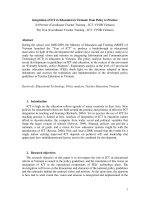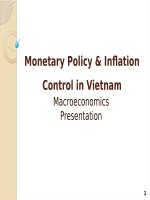monetary stability in vietnam
Bạn đang xem bản rút gọn của tài liệu. Xem và tải ngay bản đầy đủ của tài liệu tại đây (1.08 MB, 32 trang )
Monetary Stability in Vietnam
Risk Vietnam 2012 Conference
Risk
Vietnam
2012
Conference
Hanoi, May 9, 2012
Sanjay Kalra
IMF Resident Representative for Vietnam/Lao PDR
Road Map
• The
p
ast and the
p
resent
pp
Growth, inflation, and macroeconomic policies
The banking system, credit growth, and macrofinancial linkages
• The future: A framework for monetary and exchange rate
stability
2
The Past and the Present
The
Past
and
the
Present
3
The past and the present
• Growth and inflation—The tradeof
f
• Balance of payments and international reserves
• Macroeconomic policies and administrative controls
4
Growth and Inflation
30
Inflation (y/y percent change)
12
GDP Growth
(y
/
y
p
ercent chan
g
e, avera
g
e 2007-2011
)
20
8
(y y p g g
)
10
8
0
Vietnam
ASEAN
-
4
4
-10
Jan-08 Jul-08 Jan-09 Jul-09 Jan-10 Jul-10 Jan-11 Jul-11 Jan-12
Vietnam
ASEAN
-
4
NIEs China
0
5
CHN VNM IDN SGP PHL MYS TWN HKSAR KOR THA
Growth and Inflation: Tradeoff
25
15
e
nt)
5
ion (in perc
e
-5
45678910
Inflat
15
6
-
15
Real GDP Growth (in percent)
Balance of payments and International reserves
4
0
2001
2002
2003
2004
2005
2006
2007
2008
2009
2010
2011
-4
2001
2002
2003
2004
2005
2006
2007
2008
2009
2010
2011
-
8
8
Current account balance
(in percent of GDP)
7
-12
Macroeconomic policies: SBV policy rates
20
Policy interest rates (in percent)
16
12
8
Refinancing rate
Discount rate
OMO (7 day)
8
4
Jan-08 Jul-08 Jan-09 Jul-09 Jan-10 Jul-10 Jan-11 Jul-11 Jan-12
Macroeconomic policies: Fiscal deficits and public debt
2
0
-4
-2
8
-6
-10
-
8
2001 2002 2003 2004 2005 2006 2007 2008 2009 2010 2011
Fiscal Balance
(In percent of GDP)
9
Macroeconomic policies: The dong and the dollar
14,000
Exchange Rates
(dong per U.S. dollar)
14,000
16,000
16,000
18,000
18,000
20
,
000
,
22
,
000
SBV central rate
Parallel market rate
10
,
Jan-07 Jan-08 Jan-09 Jan-10 Jan-11 Jan-12
Macroeconomic policies: Administrative Controls
• Credit growth targets
• Deposit interest rate cap
• Asset markets
FX market
–
FX
market
– Gold market
• “Macroprudential” measures
– Sectoral credit allocation and lending rates for “priority” sectors
– Limits on real estate lending
•
Loan restructuring guidelines
•
Loan
restructuring
guidelines
11
The past and the present
• Bankin
g
s
y
stem in Vietnam—overbanked
,
but underbanked
gy
,
• Credit: Rapid growth … and the hangover
• Macrofinancial linkages
12
Banking system in Vietnam: Overbanked, but underbanked
13
Crowded financial and banking system …
Vietnam: Financial System Structure, 2011
35 JS Banks
18 financial Co.
13 financial leasing Co.
1 People's credit fund
100
120
Vietnam: Number of banks
7 SOCBs
4J
Vb k
60
80
4
J
-
V
b
an
k
s
5 100 pct foreign
banks
48 foreign bank
branches
Source: SBV
20
40
0
1991 1993 1995 1997 1999 2001 2005 2006 2007 2008 2009 2010 2011
14
… dominated by 5 large SOCBs
Banks' market share by credit, 2010
Banks' market share b
y
asset, 2010
SOCBs,
58 5%
Medium
JSBs 12 5%
Small JSB,
4%
(In percent)
SOCBs,
48.2%
Medium
JSBs, 15.4 %
Small JSBs,
4.6%
y
(In percent)
58
.
5%
Large JSBs
JSBs
,
12
.
5%
48.2%
Large
JSBs
,
25.1%
Large JSBs,
31.8 %
Note: Large-sized JSBs: assets over VND 60 trillion; Medium-sized: assets over VND 50 trillion; Small-sized: assets over VND 20 trillions
SSBVdFdfflli
S
ources:
SBV
, an
d
F
un
d
sta
ff
ca
l
cu
l
at
i
ons.
15
Credit: Rapid growth …
125
150
Vietnam: Credit to GDP Ratio
(In percent)
100
60
Credit growth (end period, in percent)
175
50
75
2004 2005 2006 2007 2008 2009 2010 2011
40
125
175
Asian Economies: Credit to GDP Ratio
(In percent)
20
75
Thailand
Phillipines
Indonesia
Vietnam
Malaysia
0
2003 2004 2005 2006 2007 2008 2009 2010 2011
16
25
2001 2002 2003 2004 2005 2006 2007 2008 2009 2010
and the hangover
• Liquidity problems in weak banks
• Solvency: Low capital adequacy/banks have limited buffers; banks’ NPLs—low by VAS, but much
higher by IAS/IFRS; exposure to Vinashin/financially weak SOEs unknown
•
Unsustainable business models: Growth expectations; RE prices; Noncore/other businesses
Liquidity stress Capital adequacy
1025
(Reserves
+
Treasuries
+
S
B
V
•
Unsustainable
business
models:
Growth
expectations;
RE
prices;
Noncore/other
businesses
8
20
(Reserves Treasuries S V
securities)/Deposits
SBV refinancing/Total credit (RHS)
4
6
15
2
10
17
05
2004 2005 2006 2007 2008 2009 2010 2011
Sources: SBV, and Fund staff calculations.
NPLs—size/credibility
18
The Future: A Framework for Monetary
and Exchange Rate Stability
19
Monetary Stability: Objectives and Goals
• Internal balance
Low, stable inflation
Sustainable, high growth rate
•
External balance
External
balance
Sustainable current account deficits
Stable capital flows
Build international reserves
20
The Monetary Policy Framework: Theory
• The Mundell-Fleming open
economy trilemma
Open Capital
Account
• The trilemma is not a watertight
constraint, but ensuring
macroeconomic policy
Gold
St d d
Post-Bretton
macroeconomic
policy
consistency is important, even
as central banks pursue multiple
objectives with multiple
St
an
d
ar
d
Woods
instruments.
• Pragmatism does not mean
losing sight of some of the basic
Fixed Exchange
R
Monetary
losing
sight
of
some
of
the
basic
tenets of macroeconomic policy
R
ates
Autonomy
Bretton Woods
Source: S. Y. Liew, Monetary Authority of Singapore.
21
The Monetary Policy Framework: Practice
• Restrictions on foreign capital movement, but residents shift between the dong,
USD, gold, and other assets. Vietnam approximates a small open economy with
free capital mobility If so constraints of the trilemma largely apply
free
capital
mobility
.
If
so
,
constraints
of
the
trilemma
largely
apply
• Policy implication—interest rates, credit growth and exchange rate targets
cannot be pursued simultaneously. Attempts to fix both interest rates and
exchange rates with capital mobility can result in capital inflows which
exchange
rates
with
capital
mobility
can
result
in
capital
inflows
which
overwhelm the system
• Purist approach unlikely to work reliance on range of policy tools and
instruments
interest rates quantitative credit restrictions reserve
instruments
—
interest
rates
,
quantitative
credit
restrictions
,
reserve
requirements, macro-prudential policy tools
• Practical approach must be underpinned by sound economic
principles/consistent macroeconomic policies
principles/consistent
macroeconomic
policies
• Increasingly, macro-prudential tools seen as useful complement to standard
monetary policy in EMEs, e.g., Singapore, HKSAR, Indonesia, in dealing with
capital inflows and asset price inflation pressures
capital
inflows
and
asset
price
inflation
pressures
Source: S. Y. Liew, Monetary Authority of Singapore.
22
The Monetary Transmission Mechanism in Vietnam
• Monetary policy transmission complicated by
Transition: rapid changes in the economy and financial system
Partial dollarization and asset substitution—dong, dollar, and gold
•
Analytical literature
—
Determinants of inflation
Analytical
literature
Determinants
of
inflation
Food and fuel prices
Second-round effects
Eh t
E
xc
h
ange ra
t
e
Macroeconomic policies
Supply shocks
Expectations
Expectations
23
The Monetary Policy Framework in Vietnam: Recommendations
• Near term
Exit from administrative controls
Clearly specify simple monetary policy objective, anchors, and tools
Su
pp
ortive and coordinated fiscal
p
olic
y
pp p y
Banking sector stability—address confidence and liquidity problems
24
The Monetary Policy Framework in Vietnam: Recommendations
• Medium and long term
Monetar
y
and Exchan
g
e Rate s
y
stem
ygy
Stable and predictable monetary policy
Confidence in the dong and exchange rate flexibility
Market determined exchange rate
Market
determined
exchange
rate
Enhance indirect, market-based instruments of monetary control
Improve the monetary transmission mechanism
hd l bk dh k
Furt
h
er
d
eve
l
op money, inter
b
an
k
an
d
ot
h
er mar
k
ets
Sustainable levels of public debt
Structural reforms
Banking sector
State-owned enterprises
Public investment
Capital markets
25









